Dreadnought Seamen's Hospital
King William Walk, SE10 9LS
Medical dates:
Medical character:
For merchant seamen
The
Seamen's Hospital Society was founded in 1821 to provide medical care
to merchant seamen and their dependents. The Admiralty allocated
a de-masted former naval ship (a 'hulk') to the Society - the 50-gun HMS Grampus, moored at
Deptford - for use as a hospital ship.
The accommodation eventually became inadequate and in 1831 the patients were transferred to a larger hulk, the three-decker, 104-gun HMS Dreadnought. In 1857 they were moved again to the 120-gun HMS Caledonia, which was renamed HMS Dreadnought.
When the infirmary block of the Greenwich Hospital became vacant in 1869, the Admiralty, after much debate, reluctantly agreed to lease the building to the Seamen's Hospital Society for the treatment of merchant seamen.
In 1870 the patients were transferred ashore to the infirmary. which was renamed the Dreadnought Seamen's Hospital. HMS Dreadnought herself remained in use as an isolation hospital until she was broken up in 1872.
The Dreadnought Seamen's Hospital consisted of 64 small 4-bedded wards with their own fireplaces. There were 250 patients.
By the end of the 19th century urgent medical cases from Greenwich, Blackheath and Deptford began to be treated at the Hospital. Injured labourers working on the construction of the Blackwall Tunnel also received emergency care, and the building company, Pearson, later helped to raise funds for the Hospital in acknowledgement of this.
Over the years the building was altered. Internal walls were removed to create larger wards. An operating theatre was added in the early 20th century.
In 1929 the Devonport Nurses' Home was erected across the road from the Hospital building.
During WW2 the Hospital for Tropical Diseases was evacuated to the Hospital, where it had been allocated ten beds. The building suffered bomb damage in 1940 and 1941 (which was only repaired in the late 1950s).
In 1947 the Hospital for Tropical Diseases moved back to central London. In 1948 the Dreadnought Seamen's Hospital joined the NHS. The Ministry of Health wanted the various properties of the Seamen's Hospital Society to be allocated to their appropriate region but, in the event, a Seamen's Hospital Group was set up within the NHS for the treatment of sailors.
The decline in the amount of shipping using the Thames during the latter half of the 20th century meant that fewer seamen used the Hospital. It closed in 1986 and fell into disrepair.
Present status (January 2008)
The building is now the Dreadnought Library of the University of Greenwich, converted in 1998-1999. The building needed substantial repair as wet and dry rot had damaged the timber and plasterwork.
Many of the original features of the Hospital have been retained - the ward layout, the staircases in the centre of each wing and the arcaded colonnade linking the main wings. Attractive ceramic plaques from the former ward walls are displayed in the ground floor corridor; each plaque commemorates an individual or society who contributed £1000 or more to endow a bed or a ward (Annie Zunz has a commemorative plaque here - her husband gifted 34 hospital wards in memory of her name). The adjacent Stephen Lawrence Building next door also contains some of the plaques.
The accommodation eventually became inadequate and in 1831 the patients were transferred to a larger hulk, the three-decker, 104-gun HMS Dreadnought. In 1857 they were moved again to the 120-gun HMS Caledonia, which was renamed HMS Dreadnought.
When the infirmary block of the Greenwich Hospital became vacant in 1869, the Admiralty, after much debate, reluctantly agreed to lease the building to the Seamen's Hospital Society for the treatment of merchant seamen.
In 1870 the patients were transferred ashore to the infirmary. which was renamed the Dreadnought Seamen's Hospital. HMS Dreadnought herself remained in use as an isolation hospital until she was broken up in 1872.
The Dreadnought Seamen's Hospital consisted of 64 small 4-bedded wards with their own fireplaces. There were 250 patients.
By the end of the 19th century urgent medical cases from Greenwich, Blackheath and Deptford began to be treated at the Hospital. Injured labourers working on the construction of the Blackwall Tunnel also received emergency care, and the building company, Pearson, later helped to raise funds for the Hospital in acknowledgement of this.
Over the years the building was altered. Internal walls were removed to create larger wards. An operating theatre was added in the early 20th century.
In 1929 the Devonport Nurses' Home was erected across the road from the Hospital building.
During WW2 the Hospital for Tropical Diseases was evacuated to the Hospital, where it had been allocated ten beds. The building suffered bomb damage in 1940 and 1941 (which was only repaired in the late 1950s).
In 1947 the Hospital for Tropical Diseases moved back to central London. In 1948 the Dreadnought Seamen's Hospital joined the NHS. The Ministry of Health wanted the various properties of the Seamen's Hospital Society to be allocated to their appropriate region but, in the event, a Seamen's Hospital Group was set up within the NHS for the treatment of sailors.
The decline in the amount of shipping using the Thames during the latter half of the 20th century meant that fewer seamen used the Hospital. It closed in 1986 and fell into disrepair.
Present status (January 2008)
The building is now the Dreadnought Library of the University of Greenwich, converted in 1998-1999. The building needed substantial repair as wet and dry rot had damaged the timber and plasterwork.
Many of the original features of the Hospital have been retained - the ward layout, the staircases in the centre of each wing and the arcaded colonnade linking the main wings. Attractive ceramic plaques from the former ward walls are displayed in the ground floor corridor; each plaque commemorates an individual or society who contributed £1000 or more to endow a bed or a ward (Annie Zunz has a commemorative plaque here - her husband gifted 34 hospital wards in memory of her name). The adjacent Stephen Lawrence Building next door also contains some of the plaques.

The main entrance of the Dreadnought Library of the University of Greenwich
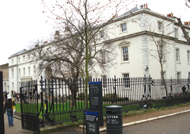
The southeast corner from Romney Road
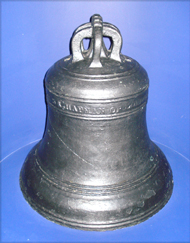
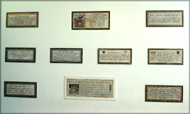

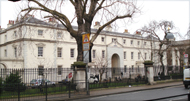
The view of the building from King William Walk
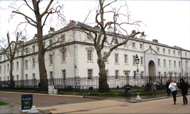
The northeast corner from the gardens at the rear
The bell from HMS Dreadnought itself can be found in the nearby National Maritime Museum
The commemorative bed and ward wall plaques can be seen at the Library and in the foyer of the adjacent Stephen Lawrence Building

www.gresham.ac.uk
www.nmm.ac.uk
www.portcities.org.uk
Return to home page